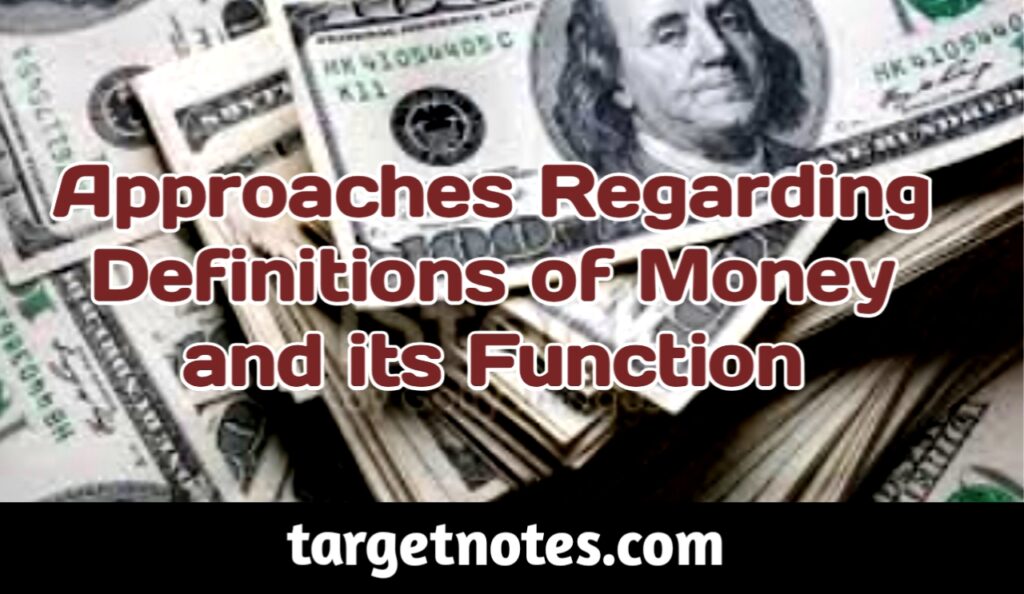
Approaches regarding Definitions of Money and its Function
What are the approaches of definitions of money? State the functions of money.
Contents
Approaches regarding Definitions of Money
Jonson and Fiege have categorised the following approaches of money:
- Conventional Approach
- Chicago Approach
- Gurley and Shaw Approach
- The Redcliff or Central Bank Approach
1. Conventional Approach:
According to J. R. Hicks, “Anything which is used as money, is money.”
In the view of classical economists –
Money = Currency + Demand deposits
2. Chicago Approach:
This approach includes the following in Money:
Money = Fixed deposits + Saving deposits + Currency + Demand
3. Gurley and Shaw Approach:
This approach was propouded by J. G. Gurley and E. S. Shaw in ‘Money in a Theory of Finance’. This approach includes the following in money :
Money = Currency + Demand Deposit + Time Deposit + Non-banking financial Intermediaries – Saving bank deposits, shares and debentures.
4. The Redcliff or Central Bank Approach:
According to this approach money includes credit from all sources :
Money = Currency + Time deposits + demand deposits + Non-banking financial intermediaries- Saving account, shares, debentures + Unorganised sector’s credit.
Functions of Money
The various functions of money can be explained as under :
(a) Main or Original Functions or Primary Functions: Main functions of money can be discussed as blow:
1. Medium of Exchange : Money is common acceptable. It acts as the intermediary in purchases and sales. On the basis of it money is referred as medium of exchange in the modern exchange system.
For example: commodity or service is converted into money and than commodities or services are received in exchange of money.
2. A Measure of Value: Money measures the values of goods and services.
For Example:
Price of one chair is Rs. 700,
Price of one book is Rs. 40,
Price of one meter cloth is Rs. 50,
Price of one kilogram tomato is Rs. 10.
When prices of all commodities are expressed in money, the comparison prices of two commodities becomes easy. Above both functions are performed at the same point of time.
(b) Secondary Functions or Subsidiary Functions of Money: Functions other than primary function can be indicated as modern functions or money. 1. Deferred Payments Standard: Money is the standard of deferred payments because :
(i) Its value is stable in comparison of the value of other commodities.
(ii) Its value is more durable.
(iii) It continues to be desirable due to common acceptability.
2. The Store of Value: With the invention of money, capital accumulation has become possible and easy.
3. Transfer of Values: The purchasing power of money transferred easily from one person to another.
If Rahul wants to reside in Lucknow from Kanpur, he can buy a new house in Lucknow after selling his house in Kanpur.
(c) Contingent Functions: In the view Prof. D. Kinley following are the contingent functions of money :
1. Basis of Credit System: Money is the basis of credit instruments. and they cannot be circulated without money. Credit note and bank note are circulated on the basis of money. It is indicated on every currency note, “I promise to pay the bearer the sum of. ………. rupees.”
2. Distribution of Social Income: On the basis of money share of factors of production is determined.
(d) Other Functions of Money: In addition to above money performs following functions:
(i) Money is the guarantor of solvency.
(ii) Money is highly important due to its liquidity.
Related Link
- Describe the various types of money
- Dynamic Functions of Money
- Evils or Demerits of Money
- Importance and significance of money in Modern Economy
- Approaches regarding Definitions of Money and its Function
- Money: Meaning, Definitions and features of Money
IMPORTANT LINK
- What is the Exchange Rate System in India?
- Evolution of foreign exchange market in India
- Meaning and importance of export finance.
- Role of Export-Import Bank in Financing India’s Foreign Trade
- How Commercial banks Export Finance to Overseas Importers?
- Explain packing credit in detail?
- What is Post-shipment credit?
- What is Pre-shipment or packing credit?
- Explain Export Credit in India?
- Institutions Providing Finance and Credit Facility for Foreign Trade
- What is Risk Analysis?
- Explain Political risks in detail? and its Types
- What are the types of Risks. Explain in detail?
- Meaning and Types of commercial risks
- How can we minimize foreign trade risks?
- What are Arbitrage operations?
- Difference between Spot Market and Forward Market
- What is spot exchange?
- Agency agreement: Meaning, Features and Advantages
- Functions of Foreign Exchange markets
- structure of Foreign exchange markets
Disclaimer






